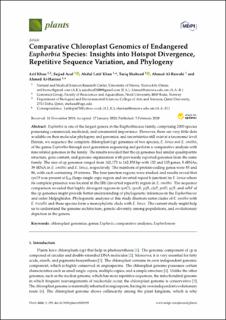| dc.contributor.author | Khan, Arif | |
| dc.contributor.author | Asaf, Sajjad | |
| dc.contributor.author | Khan, Abdul Latif | |
| dc.contributor.author | Shehzad, Tariq | |
| dc.contributor.author | Al-Rawahi, Ahmed | |
| dc.contributor.author | Al-Harrasi, Ahmed | |
| dc.date.accessioned | 2020-07-16T11:06:17Z | |
| dc.date.available | 2020-07-16T11:06:17Z | |
| dc.date.created | 2020-02-07T10:01:02Z | |
| dc.date.issued | 2020 | |
| dc.identifier.citation | Khan, A., Asaf, S., Khan, A. L., Shehzad, T., Al-Rawahi, A. & Al-Harrasi, A. (2020). Comparative chloroplast genomics of endangered Euphorbia species: Insights into hotspot divergence, repetitive sequence variation, and phylogeny. Plants, 9(2). doi: | en_US |
| dc.identifier.issn | 2223-7747 | |
| dc.identifier.uri | https://hdl.handle.net/11250/2669261 | |
| dc.description.abstract | Euphorbia is one of the largest genera in the Euphorbiaceae family, comprising 2000 species possessing commercial, medicinal, and ornamental importance. However, there are very little data available on their molecular phylogeny and genomics, and uncertainties still exist at a taxonomic level. Herein, we sequence the complete chloroplast (cp) genomes of two species, E. larica and E. smithii, of the genus Euphorbia through next-generation sequencing and perform a comparative analysis with nine related genomes in the family. The results revealed that the cp genomes had similar quadripartite structure, gene content, and genome organization with previously reported genomes from the same family. The size of cp genomes ranged from 162,172 to 162,358 bp with 132 and 133 genes, 8 rRNAs, 39 tRNA in E. smithii and E. larica, respectively. The numbers of protein-coding genes were 85 and 86, with each containing 19 introns. The four-junction regions were studied and results reveal that rps19 was present at JLB (large single copy region and inverted repeat b junction) in E. larica where its complete presence was located in the IRb (inverted repeat b) region in E. smithii. The sequence comparison revealed that highly divergent regions in rpoC1, rpocB, ycf3, clpP, petD, ycf1, and ndhF of the cp genomes might provide better understanding of phylogenetic inferences in the Euphorbiaceae and order Malpighiales. Phylogenetic analyses of this study illustrate sister clades of E. smithii with E. tricullii and these species form a monophyletic clade with E. larica. The current study might help us to understand the genome architecture, genetic diversity among populations, and evolutionary depiction in the genera. | en_US |
| dc.language.iso | eng | en_US |
| dc.publisher | MDPI | en_US |
| dc.rights | Navngivelse 4.0 Internasjonal | * |
| dc.rights.uri | http://creativecommons.org/licenses/by/4.0/deed.no | * |
| dc.title | Comparative chloroplast genomics of endangered Euphorbia species : Insights into hotspot divergence, repetitive sequence variation, and phylogeny. | en_US |
| dc.type | Peer reviewed | en_US |
| dc.type | Journal article | en_US |
| dc.description.version | publishedVersion | en_US |
| dc.rights.holder | © 2020 The Author(s) | en_US |
| dc.subject.nsi | VDP::Matematikk og Naturvitenskap: 400::Basale biofag: 470 | en_US |
| dc.subject.nsi | VDP::Matematikk og Naturvitenskap: 400::Basale biofag: 470::Genetikk og genomikk: 474 | en_US |
| dc.source.pagenumber | 19 | en_US |
| dc.source.volume | 9 | en_US |
| dc.source.journal | Plants | en_US |
| dc.source.issue | 2 | en_US |
| dc.identifier.doi | 10.3390/plants9020199 | |
| dc.identifier.cristin | 1791892 | |

